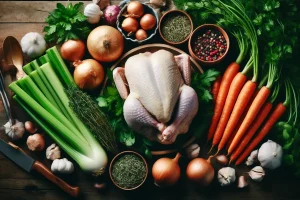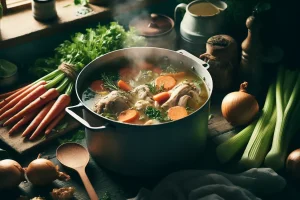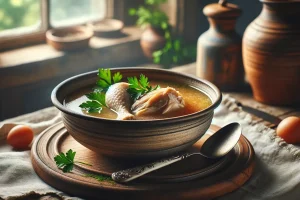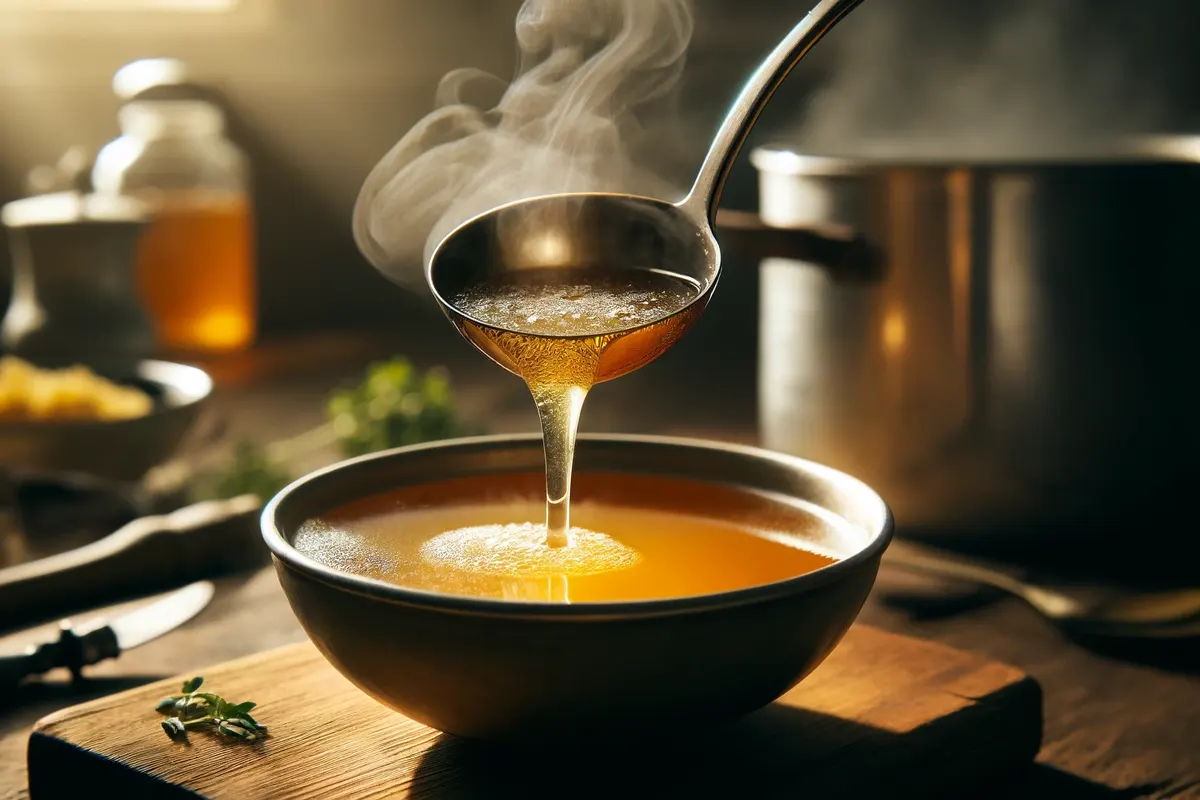In the cozy embrace of home kitchens worldwide, the humble chicken carcass whispers tales of culinary transformation, morphing from Sunday dinner remnants into a pot brimming with nourishing soup. This article delves into the art of crafting chicken carcass soup, a heartwarming concoction that speaks to the soul’s comfort and the body’s nourishment. From the alchemy of homemade broth to the symphony of vegetables and herbs, we’ll guide you through creating this timeless classic, ensuring every spoonful carries the warmth of home and the richness of tradition.
Introduction to Chicken Carcass Soup
Overview of Chicken Carcass Soup
Ah, chicken carcass soup—the quintessential comfort food that transcends cultures and generations. This culinary wonder is rooted in the traditional practice of zero-waste cooking, where every part of the chicken, particularly the carcass, is used to create a pot full of healthful goodness. Explore the World Health Organization (WHO) for further understanding of health and nutrition. Not only does this practice underscore the principles of sustainable cooking, but it also highlights the ingenuity of home chefs in creating a healthful elixir that comforts the soul and revitalizes the body.
The magic of chicken carcass soup lies not just in its ability to warm the chilliest of evenings but also in its versatility. From the bustling streets of Bangkok to the quiet countryside of Tuscany, each ladleful of this soup carries the unique fingerprint of its maker, infused with local flavors and personal touches. Whether it’s the spicy kick of ginger in Asia or the earthy notes of thyme in Europe, chicken carcass soup is a testament to the universal language of food that connects us all.
Moreover, diving into a bowl of this soup is like embarking on a journey through a mosaic of nutrients. Rich in proteins, vitamins, and minerals, this broth-based delight is not just a treat for the taste buds but a boon for the body, offering a plethora of health benefits that range from bolstering the immune system to enhancing digestion. In a world that often leans towards the fast and the convenient, chicken carcass soup stands out as a beacon of nourishment and wholesomeness, inviting us to slow down and savor the richness of life, one spoonful at a time.
Preparing the Base – Making the Broth
The Importance of Homemade Broth
In the heart of every memorable chicken carcass soup lies its soul—the broth. akin to painting on a blank canvas, the broth offers a base that absorbs and amalgamates a spectrum of flavors, enriching the soup’s character and depth. Unlike the store-bought varieties, homemade broth, simmered gently with the chicken carcass and a medley of aromatics, introduces a layer of complexity and warmth that cannot be replicated. This golden liquid is more than just a cooking medium; it’s a vessel of nutrition, brimming with essential minerals extracted from the bones, and a testament to the adage that good things come to those who wait.
Step-by-Step Guide to Making Chicken Broth
Crafting the perfect broth is a ritual that begins with the chicken carcass, the unsung hero of the kitchen. This skeleton, often overlooked, is a treasure trove of flavor waiting to be unlocked. Here’s how to transform it into a broth that sings with richness and clarity:
Gather Your Trove:
Besides the chicken carcass, summon a trinity of vegetables—carrots, celery, and onions. These, along with a bouquet garni of herbs such as thyme and parsley, will lay the foundation for a broth with depth and character.
The Simmer Dance:
Place the carcass in a large pot and submerge it in cold water. The slow seduction of heat will coax the flavors and nutrients out of the bones, creating a broth that’s both light and robust.
Whisper of Aromatics:
As the water gently bubbles, introduce the vegetables and herbs to the pot. Their essence will infuse the broth, weaving a tapestry of flavors that’s both subtle and complex.
The Art of Patience:
Allow the broth to simmer softly, skimming any impurities that rise to the surface. This patience will be rewarded with a clear, amber liquid that’s the essence of chicken soup.
Strain and Savor:
After a few hours, when the broth has absorbed the essence of its ingredients, strain it to separate the liquid gold from the solids. What remains is a clear, flavorful broth that’s the perfect starting point for your chicken carcass soup.
This broth, with its layers of flavor and nutrients, stands ready to welcome the medley of ingredients that will transform it into a heartwarming chicken carcass soup. Remember, the beauty of this soup lies not just in its taste but in the love and care that simmer in the pot, infusing the broth with the essence of home-cooked goodness.

Building the Soup
Selecting the Right Ingredients
As the broth simmers to perfection, the next step in our culinary journey is gathering the ensemble that will elevate our chicken carcass soup from a simple broth to a symphony of flavors. The selection of vegetables is pivotal; each must contribute its unique color, texture, and taste to the canvas. Classic choices like carrots, celery, and onions are non-negotiable for their aromatic contribution. Yet, the door is open for creativity—leeks for a hint of sweetness, turnips for earthiness, or kale for a burst of greenery and nutrients. The inclusion of herbs such as parsley and thyme further intertwines complexity into the soup, whispering notes of freshness and depth.
Combining Ingredients for the Perfect Soup
With our cast of characters ready, it’s time to weave them into the broth, turning it into a concoction that warms the soul and fills the belly. Here’s how to ensure every element plays its part harmoniously:
Sauté to Start:
Begin by gently sautéing the harder vegetables like carrots and onions in a dab of olive oil until they start to soften. This step is crucial for unlocking their flavors, setting the stage for a soup that’s rich in taste and aroma.
Layering the Flavors:
Once the vegetables are tender, pour in the golden broth, allowing the flavors to marry and mingle. As the broth returns to a gentle simmer, introduce softer vegetables and any additional herbs, ensuring each ingredient has its moment to shine.
The Final Flourish:
The chicken meat, tender and flavorful, makes its entrance towards the end, ensuring it remains succulent and infused with the soup’s essence. If grains or pasta are to join this culinary ballet, they should be timed perfectly to retain their texture, neither too firm nor too mushy.
Taste and Tweak:
The art of seasoning is not to be overlooked. A pinch of salt, a dash of pepper, or a sprinkle of fresh herbs can elevate the soup from good to sublime. Taste, ponder, and adjust—the soup should sing with a balance of flavors, each spoonful a testament to the care woven into its creation.
In building the soup, remember that patience is your ally and taste your guide. Each ingredient should be given the respect it deserves, allowed to contribute its voice to the chorus. The result? A chicken carcass soup that’s not just a meal but a celebration of flavors, textures, and colors—a true feast for the senses.
Customizing Your Chicken Carcass Soup
Variations and Additions
The beauty of chicken carcass soup lies in its versatility and the invitation it extends to cooks to imprint their personal touch. It’s a canvas awaiting your culinary brushstrokes, whether you’re leaning towards the comforting familiarity of classic chicken noodle or the adventurous zing of a spicy Thai-inspired version. Here are a few ideas to stir your imagination:
- Global Flavors: Infuse your soup with international flair by incorporating ingredients emblematic of various cuisines. A splash of coconut milk and a dash of curry can transport your soup to the shores of Thailand, while a sprinkle of smoked paprika and a handful of chorizo pieces can summon the spirit of Spain.
- Seasonal Twists: Let the seasons guide your additions. Spring might call for the tender crunch of asparagus, summer for the sweetness of fresh corn, fall for the earthy depth of mushrooms, and winter for the hearty embrace of root vegetables.
- Textural Contrasts: Introduce an array of textures to delight the palate. Consider silky spinach leaves, chewy barley, or even a dollop of pesto swirled in at the last moment for a creamy finish and a pop of color.

Serving and Pairing Suggestions
The final step in the journey of your chicken carcass soup is to consider its presentation and companions at the table. While the soup can undoubtedly stand as a meal on its own, the right accompaniments can elevate the dining experience:
- Bread and Beyond: A crusty loaf of bread, torn and shared, can sop up the rich broth, while homemade croutons add a satisfying crunch. For a low-carb alternative, consider serving with flaxseed crackers or almond flour rolls.
- Greens on the Side: A simple side salad, dressed lightly and peppered with fresh herbs, can offer a refreshing contrast to the soup’s warmth. Think crisp greens, juicy tomatoes, and a tangy vinaigrette.
- Comforting Complements: For a heartier meal, pair the soup with a grilled cheese sandwich, leveraging artisanal bread and a blend of cheeses for a gourmet twist on this classic comfort food.
In customizing your chicken carcass soup, embrace the freedom to experiment and the opportunity to make each batch uniquely yours. Whether sticking to the tried and true or venturing into new culinary territories, the key is to cook with intention and savor each step of the process. After all, the best dishes are those infused with personal memories, tastes, and the joy of sharing with others.

FAQs
Navigating Common Queries and Concerns
In the realm of chicken carcass soup, questions abound, from the curious novice to the seasoned home chef. Here’s a compilation of frequently asked questions, designed to demystify the process and inspire confidence in your soup-making journey.
Can I use a raw chicken carcass for the soup?
Absolutely! While many opt for the carcass of a roasted chicken for its depth of flavor, a raw carcass can also serve as a solid foundation. The key lies in the simmering process, which will extract the flavors and nutrients from the bones, regardless of their initial state.
How can I achieve a clear broth?
A clear broth is the hallmark of a carefully crafted soup. Start with cold water, bring it to a gentle simmer, and skim off any impurities that rise to the surface. Patience is crucial—avoid vigorous boiling, as it can emulsify fats into the broth, clouding its clarity.
Is it possible to make the soup vegetarian?
While the essence of chicken carcass soup lies in the use of chicken bones, a vegetarian version can still capture the comforting essence. Substitute the carcass with a robust array of vegetables and mushrooms. A dash of soy sauce or miso can add the umami depth traditionally provided by the chicken.
Can I freeze the soup for later use?
Certainly! Chicken carcass soup freezes beautifully, making it a perfect candidate for meal prep. Consider freezing in portion-sized containers for ease of thawing. Just remember, if you’ve added pasta or rice, they may become softer upon reheating.
How can I enhance the nutritional value of the soup?
To boost the soup’s health benefits, consider incorporating nutrient-dense ingredients such as kale, quinoa, or lentils. Additionally, simmering the bones for an extended period can extract collagen, contributing to the broth’s nutritional profile.
What can I do if my soup lacks flavor?
If your soup tastes a bit flat, it’s often a sign that it needs a touch more seasoning. Salt is the first go-to, but also consider acid— a squeeze of lemon juice can brighten the flavors remarkably. Fresh herbs added at the end of cooking can also infuse the soup with a vibrant, aromatic lift.
Armed with these insights, you’re now better equipped to dive into the rewarding process of making chicken carcass soup. Importantly, remember that cooking is as much about the questions we ask along the way as it is about the answers we discover. Consequently, each batch of soup offers a new opportunity to learn, adapt, and savor the delicious results.
Conclusion
As we ladle the final servings of our chicken carcass soup into bowls, steaming and fragrant, we’re reminded of the simple yet profound pleasures of cooking. This journey from carcass to comfort has not only transformed humble ingredients into a nourishing meal but has also woven a tapestry of flavors that tell a story—a story of resourcefulness, tradition, and the warmth of home.
In crafting this soup, we’ve tapped into the age-old wisdom of making the most of what we have, turning leftovers into a feast that feeds both body and soul. We’ve explored the art of broth-making, the joy of customization, and the satisfaction of answering common queries with confidence and creativity.
As you venture forth in your culinary explorations, let the lessons of chicken carcass soup inspire you. Embrace the freedom to experiment, the wisdom to ask questions, and the joy of sharing your creations with loved ones. Cooking is more than just a means to a meal; it’s a journey of discovery, connection, and the simple pleasures that make life rich and flavorful.
So, here’s to the pots yet to simmer on our stoves, the flavors yet to be discovered, and the meals that will continue to bring us together. May your chicken carcass soup be just the beginning of many more culinary adventures to come.

